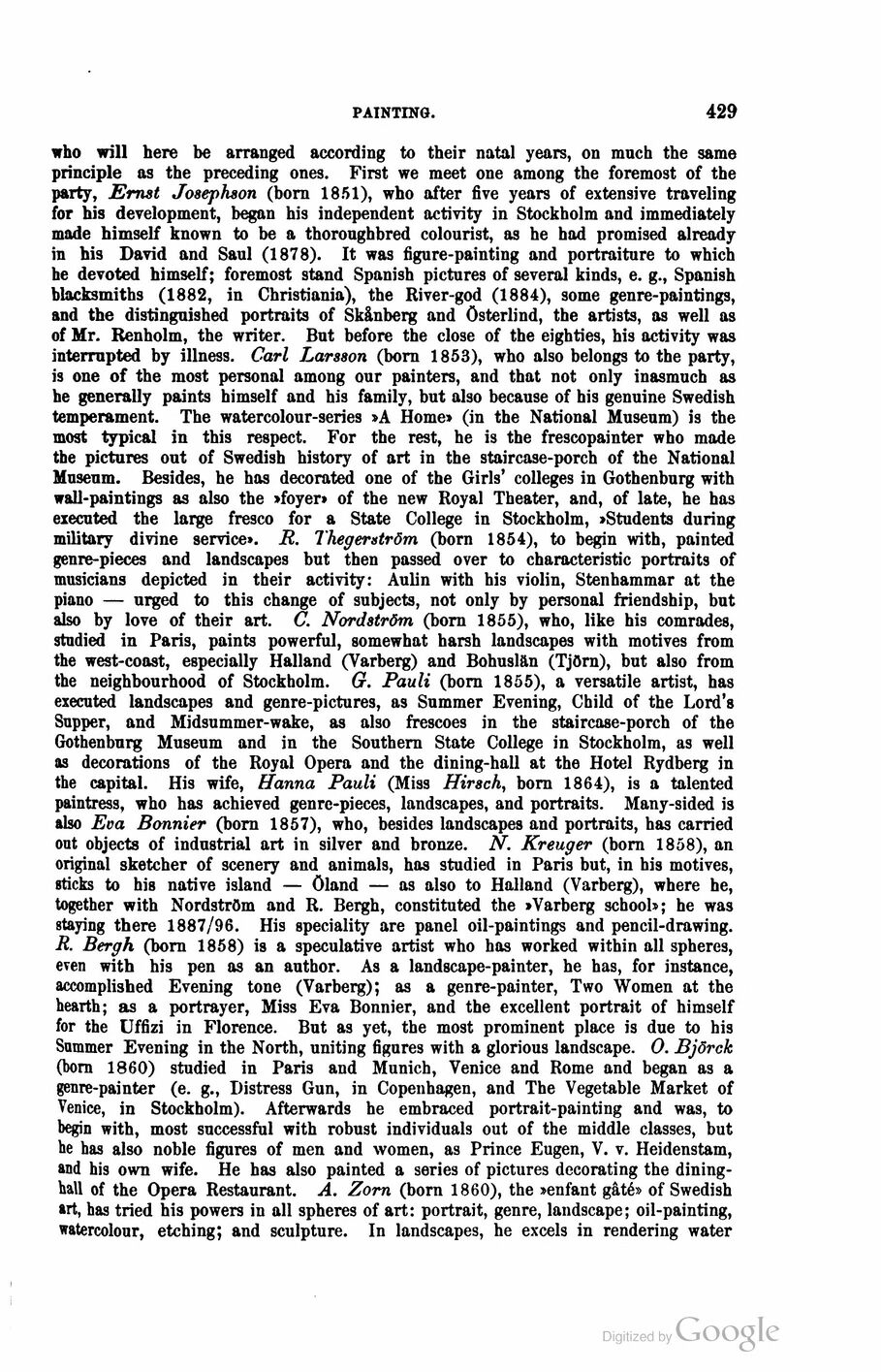
Full resolution (JPEG) - On this page / på denna sida - First part - IV. Education and Mental Culture - 9. The Fine Arts - Painting, by Prof. C. R. Nyblom, Ph. D., Stockholm

<< prev. page << föreg. sida << >> nästa sida >> next page >>
Below is the raw OCR text
from the above scanned image.
Do you see an error? Proofread the page now!
Här nedan syns maskintolkade texten från faksimilbilden ovan.
Ser du något fel? Korrekturläs sidan nu!
This page has never been proofread. / Denna sida har aldrig korrekturlästs.
PAINTING.
429
who will here be arranged according to their natal years, on much the same
principle as the preceding ones. First we meet one among the foremost of the
party, Ernst Josephson (born 1851), who after five years of extensive traveling
for his development, began his independent activity in Stockholm and immediately
made himself known to be a thoroughbred colourist, as he had promised already
in his David and Saul (1878). It was figure-painting and portraiture to which
he devoted himself; foremost stand Spanish pictures of several kinds, e. g., Spanish
blacksmiths (1882, in Christiania), the River-god (1884), some genre-paintings,
and the distinguished portraits of Skånberg and österlind, the artists, as well as
of Mr. Renholm, the writer. But before the close of the eighties, his activity was
interrupted by illness. Carl Larsson (born 1853), who also belongs to the party,
is one of the most personal among our painters, and that not only inasmuch as
he generally paints himself and his family, but also because of his genuine Swedish
temperament. The watercolour-series »A Home» (in the National Museum) is the
most typical in this respect. For the rest, he is the frescopainter who made
the pictures out of Swedish history of art in the staircase-porch of the National
Museum. Besides, he has decorated one of the Girls’ colleges in Gothenburg with
wall-paintings as also the »foyer» of the new Royal Theater, and, of låte, he has
executed the large fresco for a State College in Stockholm, »Students during
military divine service». R. Thegerström (born 1854), to begin with, painted
genre-pieces and landscapes but then passed over to characteristic portraits of
musicians depicted in their activity: Aulin with his violin, Stenhammar at the
piano — urged to this change of subjects, not only by personal friendship, but
also by love of their art. C. Nordström (born 1855), who, like his comrades,
studied in Paris, paints powerful, somewhat harsh landscapes with motives from
the west-coast, especially Halland (Varberg) and Bohuslän (Tjörn), but also from
the neighbourhood of Stockholm. G. Pauli (born 1855), a versatile artist, has
executed landscapes and genre-pictures, as Summer Evening, Child of the Lord’s
Supper, and Midsummer-wake, as also frescoes in the staircase-porch of the
Gothenburg Museum and in the Southern State College in Stockholm, as well
as decorations of the Royal Opera and the dining-hall at the Hotel Rydberg in
the capital. His wife, Hanna Pauli (Miss Hirsch, born 1864), is a talented
paintress, who has achieved genre-pieces, landscapes, and portraits. Many-sided is
also Eva Bonnier (born 1857), who, besides landscapes and portraits, has carried
out objects of industrial art in silver and bronze. N. Kreuger (born 1858), an
original sketcher of scenery and animals, has studied in Paris but, in his motives,
sticks to his native island — Öland — as also to Halland (Varberg), where he,
together with Nordström and R. Bergh, constituted the »Varberg school»; he was
staying there 1887/96. His speciality are panel oil-paintings and pencil-drawing.
R. Bergh (born 1858) is a speculative artist who has worked within all spheres,
even with his pen as an author. As a landscape-painter, he has, for instance,
accomplished Evening tone (Varberg); as a genre-painter, Two Women at the
hearth; as a portrayer, Miss Eva Bonnier, and the excellent portrait of himself
for the Uffizi in Florence. But as yet, the most prominent place is due to his
Summer Evening in the North, uniting figures with a glorious landscape. O. Björck
(born 1860) studied in Paris and Munich, Venice and Rome and began as a
genre-painter (e. g., Distress Gun, in Copenhagen, and The Vegetable Market of
Venice, in Stockholm). Afterwards he embraced portrait-painting and was, to
begin with, most successful with robust individuals out of the middle classes, but
he has also noble figures of men and women, as Prince Eugen, V. v. Heidenstam,
and his own wife. He has also painted a series of pictures decorating the
dining-hall of the Opera Restaurant. A. Zorn (born 1860), the »enfant gåté» of Swedish
art, has tried his powers in all spheres of art: portrait, genre, landscape; oil-painting,
watercolour, etching; and sculpture. In landscapes, he excels in rendering water
<< prev. page << föreg. sida << >> nästa sida >> next page >>